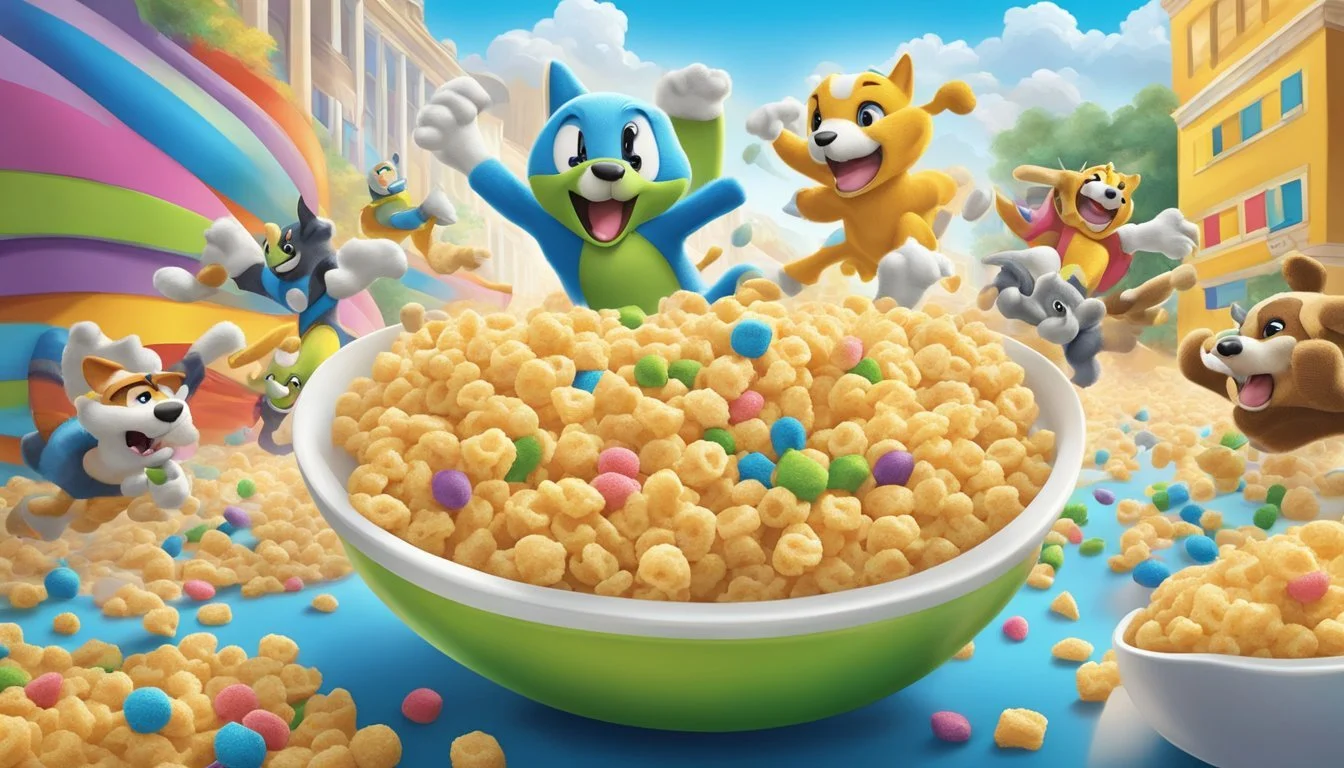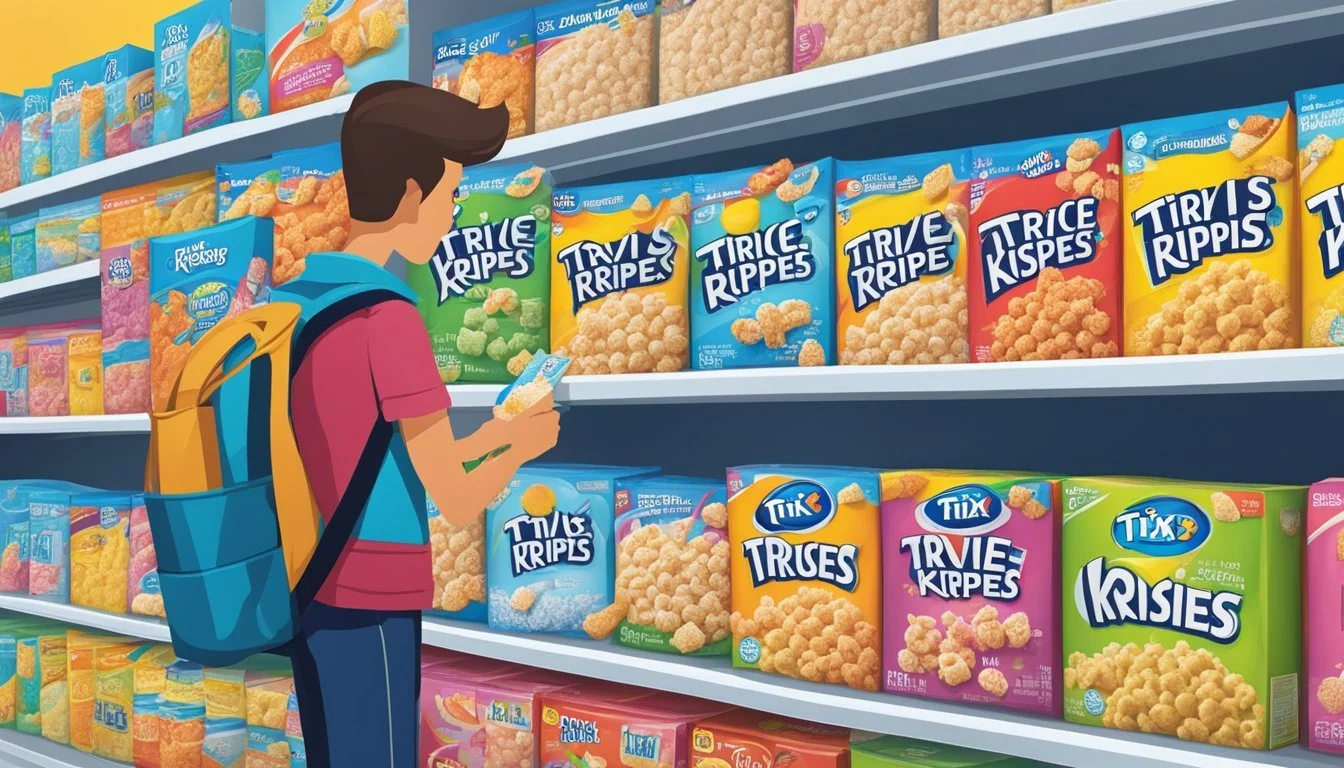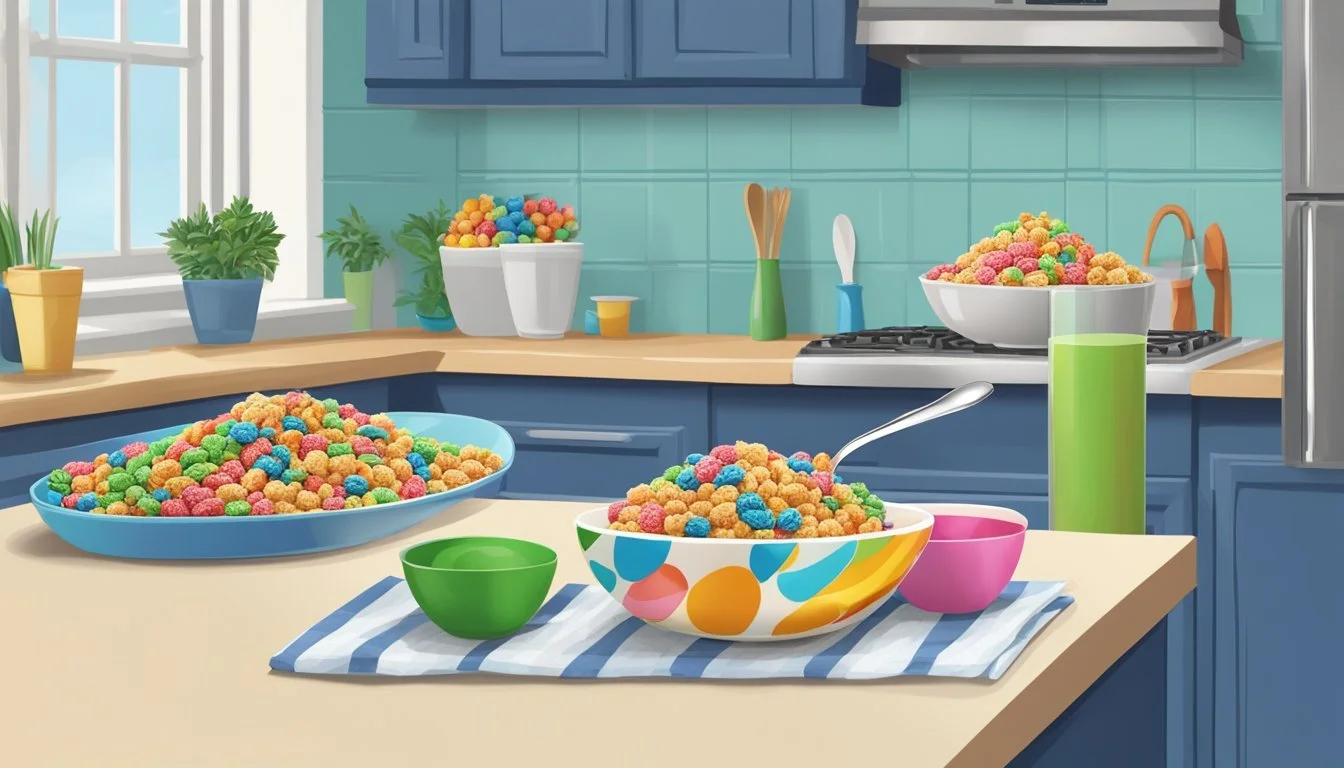Rice Krispies vs Trix
Comparing Taste, Nutrition, and Popularity
This Article is Part of Our Breakfast Cereal Guide with Details on Rice Krispies Nutrition and Trix Nutrition
When choosing between Rice Krispies and Trix, the decision often boils down to nutritional content and personal preference. Rice Krispies boasts 22.0 grams of complex carbohydrates per serving, making it a potential choice for those seeking a source of sustained energy. On the other hand, Trix contains 13.0 grams of complex carbohydrates per serving and is popular for its fruity flavors and vibrant colors.
The nutritional profile of each cereal extends beyond just carbohydrates. Rice Krispies, often considered a classic breakfast staple, is lower in sugars but may lack the playful appeal that Trix has for younger consumers. Trix, while more entertaining for a sweet-toothed audience, generally comes with a higher sugar content, which might be a consideration for those monitoring their sugar intake.
Ultimately, the choice between Rice Krispies and Trix depends on what one values more—nutritional benefits or taste and playful presentation. Both cereals have their own unique characteristics that can cater to different dietary preferences and breakfast needs. Readers are encouraged to weigh these factors to determine which cereal fits best into their morning routine.
History and Evolution
Rice Krispies and Trix have distinct histories and evolutions that reflect changing consumer tastes and marketing innovations. These cereals have undergone transformations in their recipes, shapes, and branding over the decades.
Origins of Rice Krispies
Rice Krispies were introduced by Kellogg's in 1928. Created by William Keith Kellogg, this cereal quickly gained popularity for its unique "snap, crackle, pop" sound.
The original recipe used toasted white rice and has remained largely unchanged. Its simplicity has helped it maintain a stable fan base.
During WWII, Rice Krispies were temporarily made with barley instead of rice due to shortages. The famous mascots, Snap, Crackle, and Pop, debuted in 1933, becoming iconic figures in breakfast advertising.
Development of Trix Cereal
Trix, a product of General Mills, was launched in 1954. Initially, the cereal consisted of colorful, fruit-flavored, puffed balls.
In the early 1990s, Trix changed shape to resemble fruit. This innovation appealed to younger consumers who enjoyed the fun, fruity shapes.
In 2006, Trix returned to its original round shape but discontinued artificial colors. The Trix rabbit mascot has remained a significant part of its identity, known for his catchphrase, "Silly rabbit, Trix are for kids!"
Product Composition
Rice Krispies and Trix have distinct differences in their ingredients and nutritional profiles. Understanding these differences can help consumers make informed choices based on their dietary needs and preferences.
Ingredients in Rice Krispies
Rice Krispies are primarily composed of milled rice, sugar, salt, and malt flavoring. The simplicity of its ingredients contributes to its low fat content and minimal additives.
The product features 0 grams of saturated fat and minimal levels of sodium at 290 milligrams per serving.
It contains just 2 grams of protein per serving and lacks significant amounts of fiber and vitamins. Iron and calcium content is also low, making it less nutrient-dense compared to fortified cereals.
Nutritional Profile of Trix
Trix cereal contains corn flour blend, sugar, and a mix of various color additives derived from sources like turmeric. It is substantially higher in vitamins and minerals due to fortification.
A serving of Trix provides 1 gram of protein and 1 gram of fat, including saturated fat.
It is also fortified with essential vitamins and minerals, significantly higher in iron, zinc, and multiple B-vitamins such as vitamin B6 and vitamin B1. The cereal also offers notable amounts of Vitamin A and calcium.
Finally, Trix contains a considerable quantity of sodium at 190 milligrams per serving, and its fiber content is relatively low.
These factors make Trix a more nutrient-dense option, especially for those needing higher vitamin and mineral intake.
Cultural and Brand Significance
Rice Krispies and Trix, while both popular breakfast cereals, hold unique positions in culture and branding. Their marketing strategies and cultural impact reflect their distinct identities.
Marketing Impact of Rice Krispies
Rice Krispies, created by Kellogg's, has been a staple in households for decades. Their iconic snap, crackle, and pop characters have contributed greatly to brand recognition.
Special emphasis on Rice Krispies Treats has helped position the cereal as not just a breakfast option but also a beloved snack for children and adults alike. These treats are particularly popular at parties and family gatherings, making Rice Krispies versatile.
Marketing campaigns consistently emphasize the simple, wholesome image that resonates with health-conscious families. The 0 grams of fat per serving and relatively low-calorie count make it an appealing option. This is complemented by presenting the cereal as a canvas for creativity in the kitchen, from simple snacks to elaborate party dishes.
Trix and Its Place in Pop Culture
Trix, made by General Mills, first entered the market in 1954 and quickly became known for its colorful and fun branding. The cereal's vibrant shapes and fruity flavors have always targeted a younger demographic.
One of the most memorable aspects is the Trix Rabbit, who famously fails to get his hands on the cereal, reinforcing the tagline, “Trix are for kids!” This character has been a staple in television commercials and has left a lasting impression on multiple generations.
In the '90s, Trix introduced fruit-shaped cereal pieces, enhancing the playful and engaging aspect. These shapes have become a nostalgic element, making their return a significant event for fans. Trix's influence extends beyond cereals, shaping itself as a fun, playful brand ingrained in American pop culture.
Comparative Analysis
Rice Krispies and Trix offer distinct experiences in taste, nutritional benefits, and value. The contrasts between the two cereals can influence consumer choice based on individual preferences and dietary needs.
Taste and Texture Contrasts
Rice Krispies provide a light, airy texture with a subtle taste, making them versatile for various applications, including Rice Krispie Treats. The popping sound they make when milk is added is iconic and adds to the sensory experience.
Trix, with their fruity flavor and vibrant colors, cater primarily to those who prefer a sweeter, bolder taste. Each bite offers a crunchier texture compared to Rice Krispies. The distinct shapes and colors of Trix also appeal to children and those seeking a visually appealing breakfast option.
Health and Dietary Considerations
In terms of nutrition, Rice Krispies are low in sugar and fat, providing 22 grams of complex carbohydrates per serving. This makes them a suitable option for those watching their sugar intake.
Trix cereal offers more vitamins and minerals, including Iron, Zinc, and B vitamins. However, Trix contains more sugar and calories compared to Rice Krispies, which might be a concern for those on a low-sugar diet.
It's important to note that Trix has a higher percentage of daily iron intake. On the downside, the increased sugar content may not be ideal for everyone.
Price and Value
Rice Krispies generally fall within a mid-range price point, offering good value for those who appreciate their texture and versatility. They are also frequently used in homemade treats, increasing their overall utility.
Trix, while often slightly more expensive due to their enriched nutritional profile and branding, can be seen as offering good value for those prioritizing taste and visual appeal. However, the higher sugar content might make it a less frequent purchase for health-conscious consumers.
In summary, the choice between Rice Krispies and Trix will largely depend on individual preferences, dietary requirements, and budget considerations.
Consumer Preferences
Consumer preferences for cereals such as Rice Krispies and Trix vary widely based on factors like surveyed popularity and age demographics. Understanding these preferences helps in highlighting trends and patterns among different consumer groups.
Surveyed Popularity
In a 2024 consumer survey, Rice Krispies showed consistent preference among adults looking for a plain and straightforward cereal option. They appreciated the versatility—serving as both a breakfast cereal and a key ingredient in homemade snacks like Rice Krispies treats.
Conversely, Trix appealed more to younger audiences and those with a sweet tooth. Its colorful appearance and fruity flavors made it a go-to choice for children, while adults who favored nostalgia often chose Trix over other cereals.
Age Demographics of Cereal Fans
Rice Krispies tend to attract an older demographic, particularly those above 30. These individuals often seek cereals with lower sugar content and prefer the simple, no-frills aspect of Rice Krispies. They are also more likely to use Rice Krispies in cooking and baking.
On the other hand, Trix is predominantly popular among children and teenagers. The vibrant colors and fruity flavors cater to younger taste buds, making it a staple in households with kids. Among adults, those who grew up with Trix continue to consume it, adding to its diverse age fanbase.
Creative Uses in the Kitchen
Rice Krispies and Trix can each serve as the cornerstone for a variety of innovative and enjoyable recipes. Whether employing the classic flavor of Rice Krispies or the colorful crunch of Trix, these cereals transform simple ingredients into creative culinary creations.
Rice Krispies Treats Recipes
Classic and versatile, Rice Krispies treats are transformed using just a few ingredients.
Rice Krispies treats start with butter, marshmallows, and the iconic crispy rice cereal. Melt butter and mini marshmallows over low heat until fully combined into a gooey mixture. Add a pinch of salt and a splash of vanilla extract for enhanced flavor. Once the marshmallow mixture is ready, mix in the crispy rice cereal until well-coated. Spread the mixture into a greased pan and let it cool before cutting into squares.
For a twist, incorporate ingredients like chocolate chips, peanut butter, or even sprinkles. Using different flavored cereals, like Cocoa Krispies, can also offer a delightful change. These no-bake desserts are perfect for any occasion, proving that simplicity can still lead to sweet satisfaction.
Innovative Desserts with Trix
Ready to elevate your treats? Trix offers a colorful and playful alternative to traditional cereal.
Creating desserts with Trix involves similarly straightforward steps. Start with the same base of butter and marshmallows. Melt them together until smooth, then mix in Trix cereal. The vibrant colors of Trix add a festive touch to any dessert table. Press the mixture into a greased pan and allow it to set before slicing.
For more unique spins, consider adding white chocolate chips or drizzling with a chocolate or caramel sauce. Another inventive approach is to incorporate Trix into other desserts, such as using it as a crust for cheesecake or a topping for ice cream. These no-bake desserts not only look appealing but also provide that nostalgic taste of childhood.
Purchase and Availability
Both Rice Krispies and Trix cereal are widely available through various purchasing options, making it easy for consumers to find them in both physical and online stores.
Grocery Store Placement
Rice Krispies and Trix can typically be found in the cereal aisle of most grocery stores.
Rice Krispies, produced by Kellogg’s, is usually placed on shelves at eye level due to its popularity and high turnover rate.
Trix, a product of General Mills, is often placed nearby, allowing for easy comparison by consumers.
Popular grocery chains like Walmart, Target, and Kroger stock these brands across their numerous locations.
In addition to large chain stores, both cereals are also available at smaller, local grocery stores.
Sales and promotions are common, often providing opportunities to purchase either cereal at a discounted price.
Online Shopping Options
Online shopping is another convenient way to purchase both Rice Krispies and Trix cereals.
Retail giants like Amazon, Walmart, and Target offer both cereals with options for home delivery or store pickup.
Subscription services are available through these platforms, allowing consumers to receive regular deliveries at intervals they choose.
Other online grocery services like Instacart and Shipt also carry these cereals, providing same-day delivery based on local stock availability.
Additionally, the official websites of Kellogg’s and General Mills sometimes offer special deals or coupons for purchasing directly.
Overall, the wide availability through multiple channels makes it convenient for consumers to purchase either Rice Krispies or Trix.
Conclusion
When comparing Rice Krispies and Trix, several key differences emerge.
Nutritional Content:
Complex Carbohydrates: Rice Krispies contains 22.0 grams per serving, while Trix has 13.0 grams.
Vitamins and Minerals: Trix offers higher levels of Iron, Zinc, Vitamin B6, Vitamin B2, Calcium, and Fiber compared to Rice Krispies.
Taste and Texture:
Rice Krispies are known for their light, crispy texture.
Trix stands out with its fruity flavors and more vibrant color palette.
Health Considerations:
Rice Krispies has a moderate carbohydrate content.
Trix, while rich in vitamins, often contains more sugar.
Both cereals cater to different preferences. Rice Krispies may appeal to those seeking a simpler, lower-sugar option. In contrast, Trix might attract individuals looking for a nutrient-dense, flavorful choice. Selecting the better option depends on the nutritional needs and taste preferences of the individual.







